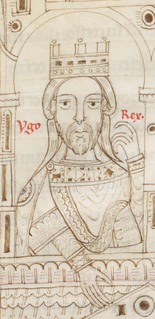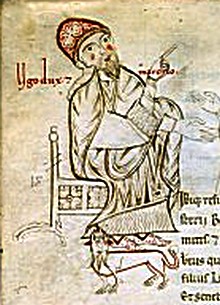Louis the Blind was the king of Provence from 11 January 887, King of Italy from 12 October 900, and briefly Holy Roman Emperor, as Louis III, between 901 and 905. His father was a Bosonid and his mother was a Carolingian. He was blinded after a failed invasion of Italy in 905.

Hugh, known as Hugh of Arles or Hugh of Provence, was the king of Italy from 926 until his death. He belonged to the Bosonid family. During his reign, he empowered his relatives at the expense of the aristocracy and tried to establish a relationship with the Byzantine Empire. He had success in defending the realm from external enemies, but his domestic habits and policies created many internal foes and he was removed from power before his death.

Berengar I was the king of Italy from 887. He was Holy Roman Emperor between 915 and his death in 924. He is usually known as Berengar of Friuli, since he ruled the March of Friuli from 874 until at least 890, but he had lost control of the region by 896.

Berengar II was the King of Italy from 950 until his deposition in 961. He was a scion of the Anscarid and Unruoching dynasties, and was named after his maternal grandfather, Berengar I. He succeeded his father as Margrave of Ivrea around 923, and after 940 led the aristocratic opposition to kings Hugh and Lothair II. In 950 he succeeded the latter and had his son, Adalbert crowned as his co-ruler. In 952 he recognised the suzerainty of Otto I of Germany, but he later joined a revolt against him. In 960 he invaded the Papal States, and the next year his kingdom was conquered by Otto. Berengar remained at large until his surrender in 964. He died imprisoned in Germany two years later.
Adalbert II, called the Rich, son of Adalbert I, Margrave of Tuscany and Rothild of Spoleto. He was a grandson of Boniface II, and was concerned with the troubles of Lombardy, at a time when so many princes were contending for the wreckage of the Carolingian Empire. Before his father died in 884 or 886, he is accredited the title of "count". He inherited from his father the titles of Count and Duke of Lucca and Margrave of Tuscany.

Adalbert was the king of Italy from 950 until 961, ruling jointly with his father, Berengar II. After their deposition, Adalbert continued to claim the Italian kingdom until his defeat in battle by the forces of Otto I in 965. Since he was the second Adalbert in his family, the Anscarids, he is sometimes numbered Adalbert II. His name is occasionally, especially in older works, shortened to Albert.
Boso was a Burgundian nobleman who spent much of his career in Italy, where he became Margrave of Tuscany about 932. He ruled semi-autonomously and was a benefactor of the churches of his region. He lost his office in 936 and probably returned to Burgundy.
Guy was the margrave of Ivrea from 950 to his death. In 950, his father, King Berengar II of Italy, appointed him to rule in the familial margraviate. His mother was Willa of Tuscany, his elder brother was Adalbert II, co-king with their father, and their younger brother was Conrad.

Hugh, called the Great, was the Margrave of Tuscany from 969 until his death in 1001, and the Duke of Spoleto and Margrave of Camerino from 989 to 996. He was known for his restoration of the state apparatus in Tuscany after decades of neglect from various Margraves, whose main interests lay elsewhere. Hugh was also noted for his support of the new Ottonian dynasty, and has been praised for his justice by the contemporary theologian Peter Damian in his De principis officio. Hugh's rule has also been remembered for its close cooperation with the Papal States in the resolution of territorial disputes and his generosity in gifting marchesal (public) lands for the foundation of monasteries of the Catholic Church.
The March of Ivrea was a large frontier county (march) in the northwest of the medieval Italian kingdom from the late 9th to the early 11th century. Its capital was Ivrea in present-day Piedmont, and it was held by a Burgundian family of margraves called the Anscarids. The march was the primary frontier between Italy and Upper Burgundy and served as a defense against any interference from that state.
Adalbert I was the margrave of Ivrea, the second of the Anscarid dynasty, from the late 890s until his death. In the intermittent civil war which affected Italy from 888 into the 930s, Adalbert initially strove to remain neutral, but from 901 on he sided sequentially with every claimant to the Italian throne.
Bertha was countess of Arles by marriage to Theobald of Arles, and margravine of Tuscany by marriage to Adalbert II of Tuscany. She served as regent of Lucca and Tuscany from 915 until 916 during the minority of her son Guy of Tuscany. She was described as beautiful, spirited and courageous, while her influence over her spouse was, coupled with ambition, attributed to have involved her husbands in many wars.
The Bosonids were a dynasty of Carolingian era dukes, counts, bishops and knights descended from Boso the Elder. Eventually they married into the Carolingian dynasty and produced kings and an emperor of the Frankish Empire.
Willa, known as Willa of Tuscany (911/912–970), was a medieval noblewoman. By birth, she was a member of the Bosonid noble dynasty. By marriage to Berengar II of Italy she was Countess of Ivrea from 930 to 963, and queen consort of Italy from 950 to 963.
Conrad Cono(n) was the Margrave of Ivrea from 970 to his death and Duke of Spoleto and Camerino (996–997). He was the third son of Berengar II of Italy and Willa of Tuscany. His elder brothers were Adalbert and Guy, both of whom ruled the march before him. His father made him, possibly, the first Count of Ventimiglia.
Bertila of Spoleto was the wife of Berengar I of Italy, and by marriage Queen consort of Italy and Holy Roman Empress.
Anscar was a magnate in the Kingdom of Italy who served as Count of Pavia, Margrave of Ivrea (929–36) and Duke of Spoleto (936–40). He is sometimes numbered "Anscar II" to distinguish him from his grandfather, Anscar I of Ivrea. Described by Liutprand of Cremona as courageous and impulsive, he died in the battle of Spoleto.
Sarlio was the Duke of Spoleto from 940 until 943. He was originally from Provence and served as a count of the palace under King Hugh.
Willa of Burgundy was a member of the Elder House of Welf. By birth she was a daughter of Rudolph I of Burgundy, king of Upper Burgundy. Through marriage Boso Willa became countess of Avignon and Arles, and then margravine of Tuscany.
Willa of Spoleto was the daughter of Boniface I, duke of Spoleto. Through marriage to Hubert, Duke of Spoleto Willa became duchess of Spoleto and margravine of Tuscany.